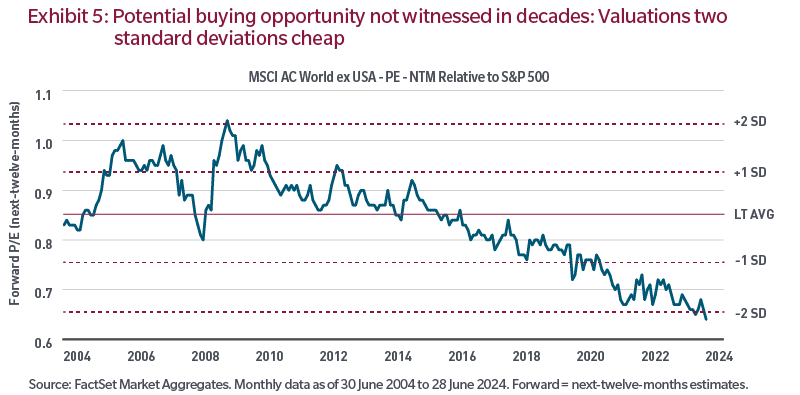by Nicholas Paul, CFA, Equity Portfolio Manager, MFS Investment Management
Key takeaways
- Coming out of the global financial crisis, rates and inflation were low and headed lower and liquidity was high. Today, rates and inflation are meaningfully higher and liquidity is shrinking. Starting points matter.
- Over the past decade, many great companies around the world have simply been overshadowed by the outsized returns of US mega-cap technology companies, which disproportionately benefited from the perfect storm of low interest rates (as these tend to be long duration assets), digitalization, the “stay-at-home trade” and, more recently, investor euphoria related to Gen AI.
- Today, while technology remains a vibrant investment opportunity, we believe a much broader subset of sectors and industries appear well positioned to benefit from future trends such as increased capex spending (versus opex only), infrastructure upgrades, energy and the energy transition, defense and national security, as well as the reshoring and the localization of supply chains, just to name a few.
- Generally, investing in the best companies — those with pricing power and margin stability — both in the US as well as non-US, versus just buying a single region or style (i.e., US growth), could help maximize returns for investors while providing the benefits of diversification.
In my experience, only a few market tenets stand the test of time. One of them is that starting points matter, which is particularly relevant today, and the other is the time-tested benefits of diversification. I think we can all agree that if you take today as a starting point, investing over the next ten-plus years will likely be quite different from what we’ve grown accustomed to over the past decade plus. The level of interest rates and inflation, the likelihood of additional liquidity from central banks, equity valuations and profit margins — all these factors look quite different than they did at the start of the bull market that followed the global financial crisis (GFC), and while diversification was a headwind for the decade following the GFC, it will likely play a significant role in portfolios over the coming decade.
The past doesn’t always repeat, but at times it may rhyme ...
It’s well understood that relative performance between US and international stocks has historically rotated. Some market conditions favor the companies in the US, a more growth-oriented asset class, while others favor companies in international countries, which, generally speaking, tend to be more value oriented. We believe the next business cycle — which is likely to be defined by higher inflation and interest rates, as well as a broader subset of investment opportunities — will look quite different than the last and international companies may be better positioned to potentially benefit, just as they did in the early 2000s.
While relative performance ebbs and flows over time, the eight-year period coming out of the dot-com era, up until the GFC (2000 to 2007), was the last time we witnessed a sustained period of outperformance for international stocks versus their US counterparts. And while no two periods are alike, there are a number of parallels one could draw between that period, starting in the early 2000s, to today’s market environment.

The parallels are as follows:
Inflation and interest rates – Directionally, the path of interest rates was much different during the start of the 2000s, with interest rates moving lower versus what we witnessed in 2022, where rates moved sharply higher. However, over that eight-year period, interest rates and inflation were quite stable. In fact, over that eight-year period, 10-year treasuries averaged 4.7% and global inflation 3.7%, which is much more aligned with today’s reality — and the market backdrop we are likely to face moving forward — versus a world of zero inflation and the zero (in some cases negative) interest rate environment that categorized the decade post the GFC. And while rates may in fact trend a bit lower over the near term, I think we’d all agree that the prospects of going back to a world of ZIRP (Zero Interest-Rate Policy), benefiting higher multiple long-duration growth stocks, is highly unlikely. In this context it makes sense that asset classes with more exposure to cyclical areas of the market (i.e., international, value) did quite well during this period as these tend to be areas of the market that benefit the most from “healthy” inflation and higher rates. In fact, this trend started to play out, beginning in October 2022, once the initial rise in rates was absorbed by the market. From October of 2022 through the early part of 2023, we started to witness a rotation from both growth to value and from US leadership to international leadership. . . and then what happened? Well, early in 2023, Generative AI swept in and “saved the day” for the Magnificent 7. But if not for Gen AI (I know, it’s hard to say that with a straight face ), we would be looking at a very different market environment today.

Concentration risk – Speaking of Gen AI, extreme concentration risk in US tech is also reminiscent of the period leading up to the early 2000s (dot-com bubble ring a bell?). With that said, the mega-cap technology companies of today are clearly high-quality businesses and not analogous with the Pets.com or the eToys of the dot-com era. However, if earnings expectations for these largely concentrated areas of the market were not to live up to the lofty expectations embedded in their stock prices, and multiples derate, the relative value opportunity for international stocks could be tremendous. In addition, this concentration risk in market cap–weighted benchmarks has also masked the strong performance of many great non-US companies. In fact, historically, as Exhibit 4 illustrates, most of the best-performing stocks globally have been non-US-listed companies.


Low return environment for US stocks – Following the bursting of the dot-com bubble in the early 2000s, we witnessed a period of low returns for US equities. In fact, over that eight-year period, while international equities, as measured by the MSCI ACWI ex-US Index, were up 74.6% (7.2% annualized) the S&P 500 was up just 14.1% (1.7% annualized) and the tech-heavy Russell 1000® Growth was down 21.2% (-2.9% annualized). So if, or perhaps more likely when, the euphoria around Generative AI becomes fully baked into these mega-cap tech stocks that dominate today’s US benchmarks, we could be setting ourselves up for an extended period of low absolute returns, which would also certainly rhyme with what we witnessed from 2000 to 2008.

Valuations – I purposely left valuations last on the list of parallels, as this has been the “base case” for investing in international markets over the last decade. Unfortunately, as we’ve come to find out, valuation alone is not an investment thesis and things can stay “cheap” for a long time without a catalyst. However, you would once again have to go back to the early 2000s to find a buying opportunity as attractive as it stands today as international stocks are trading at two standard deviations “cheap” relative to their US counterparts. Additionally, while lofty valuations didn’t matter much in a world of zero inflation, zero interest rates and access to essentially “free” capital, in world of higher rates, higher inflation and less liquidity, they matter greatly.

Future trends should likely benefit a broader range of companies
In addition to the parallels between today’s market environment and that of the early 2000s, perhaps more importantly, while technology and artificial intelligence will be an important part of our daily lives, we believe future trends will likely benefit a wider cohort of sectors and industries outside of just the technology-centric US companies of the past decade. Trends such as increased capex spending (versus opex only), spending to upgrade infrastructure, energy and the energy transition, defense and national security, as well as the reshoring and the localization of supply chains, just to name a few. And while many US companies stand to benefit from these trends, many more international companies stand to benefit as well. And while the US dominates the technology landscape globally, it would be naïve to assume that all the best companies in the world across a wide subset of sectors and industries reside in a single region or country.
Conclusion
So just to bring things full-circle, I think we can all agree that over the next decade, whether it's monetary or fiscal policy, inflation or interest rates, or areas where future investments are likely to be made, all point to a landscape vastly different from the past decade and one where market leadership should expand across a wider subset of sectors and industries (versus just mega-cap tech) as well as countries and regions (both US and international). Additionally, in a world of higher interest rates and higher inflation, what you pay for the companies you own (i.e., valuation) and the quality of businesses you own will matter greatly.
Finally, and perhaps most importantly, the long-standing benefits of diversification, in what could prove to be a more difficult environment for risk assets versus the prior decade where quantitative easing and access to “free” capital was abundant, could potentially help investors meet their long-term investment goals as we enter this new and much different cycle versus the last. Starting points matter.
*****
The views expressed are those of the author and are subject to change at any time. These views are for informational purposes only and should not be relied upon as a recommendation to purchase any security or as a solicitation or investment advice from the Advisor. No forecasts can be guaranteed. Past performance is no guarantee of future results.
“Standard & Poor’s®” and S&P “S&P®” are registered trademarks of Standard & Poor's Financial Services LLC (“S&P”) and Dow Jones is a registered trademark of Dow Jones Trademark Holdings LLC (“Dow Jones”) and have been licensed for use by S&P Dow Jones Indices LLC and sublicensed for certain purposes by MFS. The S&P 500® is a product of S&P Dow Jones Indices LLC and has been licensed for use by MFS. MFS’s Products are not sponsored, endorsed, sold or promoted by S&P Dow Jones Indices LLC, Dow Jones, S&P, or their respective affiliates, and neither S&P Dow Jones Indices LLC, Dow Jones, S&P, their respective affiliates make any representation regarding the advisability of investing in such products.
Index data source: MSCI. MSCI makes no express or implied warranties or representations and shall have no liability whatsoever with respect to any MSCI data contained herein. The MSCI data may not be further redistributed or used as a basis for other indices or any securities or financial products. This report is not approved, reviewed or produced by MSCI.
Frank Russell Company (“Russell”) is the source and owner of the Russell Index data contained or reflected in this material and all trademarks, service marks and copyrights related to the Russell Indexes. Russell® is a trademark of Frank Russell Company. Neither Russell nor its licensors accept any liability for any errors or omissions in the Russell Indexes and/or Russell ratings or underlying data and no party may rely on any Russell Indexes and/or Russell ratings and/or underlying data contained in this communication. No further distribution of Russell Data is permitted without Russell’s express written consent. Russell does not promote, sponsor or endorse the content of this communication.
Copyright © MFS Investment Management















